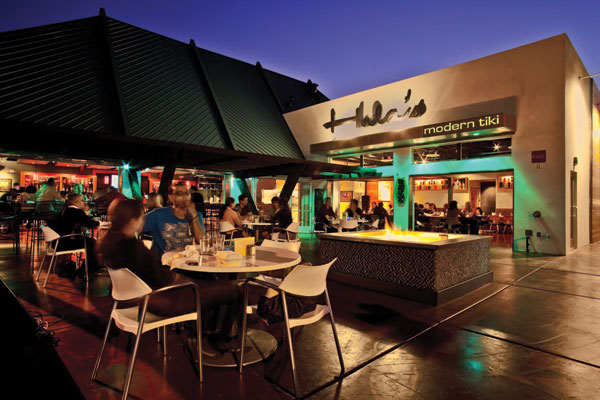For one restaurant, green means more than just the bill
BY KRISTIN GLOCKSIEN

A drive through the Central Corridor of downtown Phoenix today is a lot different than it was even five years ago. The adaptation of old buildings for new life (adaptive reuse) has recently been flourishing in Phoenix more than in any other Valley city. And for those mid-century minded, the restaurant Hula’s Modern Tiki on Central Avenue, just south of Camelback, is an Atomic Age lover’s paradise.
Owner and Phoenix native Dana Mule spent a considerable amount of time looking for the perfect location to open his Hawaiian-inspired restaurant before he finally found the quirky building along Central Avenue. “We [Mule and partners Chris and Craig Delaney] fell in love with the building, and wanted to ensure that we were respectful of the architectural fabric of uptown Phoenix,” Mule said.
Conveniently located along the light rail, Hula’s Modern Tiki opened in September 2009 and business has been booming ever since. “Given the current state of the local and national economy, we have been very blessed to see our business slowly grow since we opened,” Mule admits.
The building, located at 4700 N. Central Avenue, used to house Heap Big Beef sandwiches in the 1960s and, after that, a flower shop. According to Mule, the building, which has a rather peculiar hexagonal exterior, is much more visibly stimulating than it was in the ‘60s. “The original A-frame structure pays subtle homage to the Polynesian island culture, and the classic tiki bars and restaurants of the ’40s and ’50s,” he said.
With the added touches of Polynesian-tropical-island-influenced cuisine and a modern, mid-century take on design, Hula’s Modern Tiki is a restaurant for all ages. “As soon as you step into Hula’s, you feel the renewed spirit and energy we imbued into the original structure by turning it into something relevant and modern without losing the [building’s] original integrity,” Mule said.
What makes Hula’s unique to Metro Phoenix is a combination of great food, unique, cool cocktails, and a hip, casual and urban atmosphere. “By taking an iconic, yet ailing mid-century building and turning it into a new, vibrant, urban space, [it provides a place] for the people of this community to gather and interact,” Mule said.
After a $1 million renovation, Mule doubled the size of the building to 2,900 square feet and added seating for up to 125 people at the indoor bar and an outdoor patio area.
Adaptive reuse is the process of adapting old structures for new purposes. Since many old buildings outlive their original purposes, adaptive reuse allows these buildings to bring new life to the community while maintaining their historic value.
Mule believes that an adaptive reuse program allows the city to “generate jobs and revenue by opening new business, while still maintaining the integrity, texture and history of Phoenix’s original architecture.”
The city’s Adaptive Reuse Program began as a pilot program in April 2008 and has since become one of the most comprehensive of its kind in the nation. The program “offers development guidance, expedited time frames and reduced costs to customers looking to ’recycle’ older buildings for new business uses” as stated on the City of Phoenix website. The idea of adaptive reuse “preserves our history, contributes to economic vitality, promotes building effort and creates a more vibrant downtown neighborhood,” it continues.
Mule explains that because Hula’s was renovated at the start of the Adaptive Reuse Program, he encountered some difficulties. He says Councilman Tom Simplot is a huge supporter of the program, and “was instrumental in helping us overcome some key issues related to it.”
Since opening Hula’s Modern Tiki, Mule has had firsthand experience watching the revitalization of downtown Phoenix. “This community/area of Phoenix is the only place to be if you want that hip, diverse, urban-cultural vibe,” he said. “The light rail is a boon as well, since it makes uptown accessible in a way that it never was before.”
As part of their growth and dedication to sustainability, two electric car charging stations were just installed along the building’s west side – visitors can eat and charge at the same time!
Hula’s Modern Tiki is using adaptive reuse to its advantage and has started a trend that could be the catalyst for continued revitalization in Phoenix, making the Central Corridor the envy of the rest of the Valley. “My hope is that new business will continue to open here, perpetuating the process of revitalizing the entire Central Corridor, and bringing so many of these great, old structures back to life,” Mule said.






